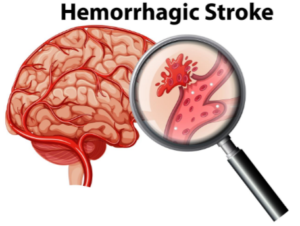
The problem with comparing a TIA headache with a ruptured brain aneurysm is if the sudden headache is a burst aneurysm, you don’t have minutes to wait around and see what happens.
The headache pain caused by a ruptured brain aneurysm may last only a minute — because after one minute, you may be unconscious—and therefore unable to feel any pain!
Death may be just minutes away.
An aneurysm is a dilated blood vessel.
Its presence can go unnoticed until it’s accidentally discovered via a CT scan or MRI for an unrelated condition.
Two Kinds of Aneurysm Headaches
The first is from a leaking aneurysm. A sudden severe headache may result, then go away, then come on suddenly days or a few weeks later in the form of a thunderclap: the worst headache imaginable—and very fast in onset.
The aneurysm has ruptured; every second counts for survival.
When an aneurysm leaks, there may not be a headache, but instead a drooping eyelid and maybe a constricted pupil.
On the other hand, these symptoms may be present with the sudden headache from the leaking.
At the time of rupture (called a hemorrhagic stroke), the patient may have only the thunderclap headache; no other symptoms.

Vecteezy.com
Pain from this condition will not subside. The natural course, if not treated, is for the patient to lose consciousness and then die.
The second kind of brain aneurysm is one that sits there silently for years, no leaking, and then the first symptom is the thunderclap headache when the dilated portion of the blood vessel suddenly bursts.
A rupture is always a medical emergency, immediately life-threatening.
A silent brain aneurysm can rupture in response to physical exertion or even straining sexual activity.
“TIA Headaches”
Well actually, there’s essentially no such thing. TIAs cause all sorts of symptoms (e.g., one-sided weakness, one-sided limb paralysis, one-sided facial paralysis, slurred speech, visual disturbances), but a headache is usually not one of them.
“Headache, especially when severe, is not routinely a symptom of a TIA,” says Michael Sellman, MD, neurology division chief with the Greater Baltimore Medical Center’s Center for Neurology.
“There are many other causes of severe headache,” says Dr. Sellman, “but TIA is not one of them.”
So does this mean that if that sudden, excruciating headache is not a transient ischemic attack, it’s necessarily a ruptured brain aneurysm?
No. It may be from a migraine, pinched nerve in the neck, the so-called icepick headache that often has no known cause, and from sinusitis.
In fact, a sinusitis headache can be mistaken for a ruptured aneurysm.
 Dr. Sellman’s interests are in clinical neurophysiology and neuromuscular disorders. He previously served as chief of the Division of Neurology at Mercy Medical Center since 2002.
Dr. Sellman’s interests are in clinical neurophysiology and neuromuscular disorders. He previously served as chief of the Division of Neurology at Mercy Medical Center since 2002.
 Lorra Garrick has been covering medical, fitness and cybersecurity topics for many years, having written thousands of articles for print magazines and websites, including as a ghostwriter. She’s also a former ACE-certified personal trainer.
Lorra Garrick has been covering medical, fitness and cybersecurity topics for many years, having written thousands of articles for print magazines and websites, including as a ghostwriter. She’s also a former ACE-certified personal trainer.
.


























